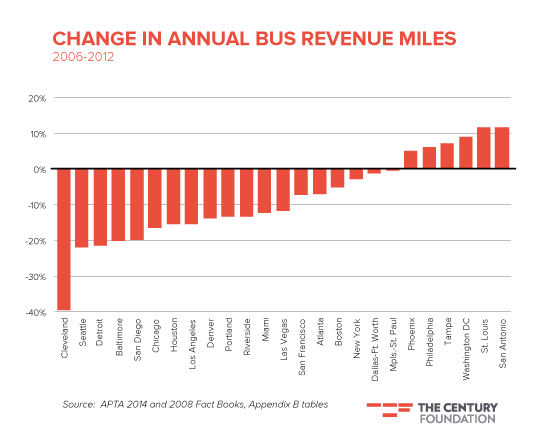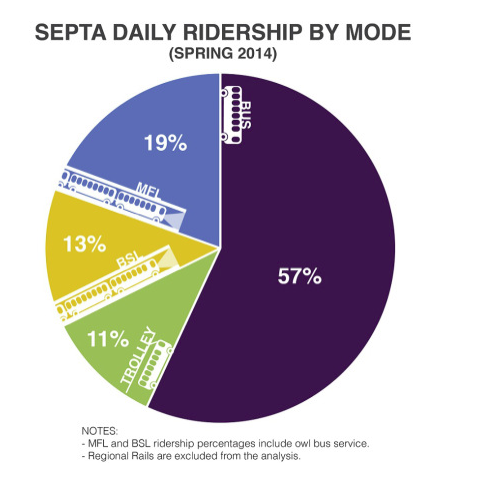Why Philadelphians Are Head Over Heels In Love With Their Buses
Earlier this month, statistics came out showing just how much bus ridership in New York City has plummeted there since the Great Recession. Frankly, it’s shocking. There were 162,000 fewer daily riders on weekdays in 2014 than in 2009 — i.e., roughly six fewer bus rides per year for every New Yorker.
And New York is hardly an outlier. Chicago’s bus ridership dropped 8 percent last year alone. Los Angeles’ was down 3 percent. And Detroit’s swan-dived a staggering 14 percent.
When the decline in bus ridership began back in 2008, it was thought to be a momentary dip due to high unemployment (fewer jobs meant less commuting, and less commuting meant less ridership, the logic went). Instead, buses have continued to get the cold shoulder in favor of subways and light-rail — which have gained so many riders nationwide, they’ve managed to offset the bus slump and boost public transit ridership to record heights.
By now, it’s clear that a shift in Americans’ palate for transit has solidified, with the “Magic (Disappearing) Bus” getting left behind, writes the Century Foundation:
… the strengthening economy has failed to translate back into an increase in bus ridership. Unemployment peaked at 10 percent in October 2009 and has since fallen by nearly half, yet the majority of large urban areas saw fewer bus passengers last year than they did at the height of the recession.
Interestingly, though, the major decline isn’t happening in Philly.
In fact, the number of people who took SEPTA buses every year between 2009 and 2013 actually increased; that’s the same stretch of time during which New York City was shedding tens of thousands of riders.
There’s a caveat, though: According to data from the American Public Transportation Association, Philly buses had 2.8 percent fewer riders in 2014 than they did a year prior. But subway ridership was down as well, by 1.8 percent, meaning SEPTA’s automobile and rail divisions are not headed in starkly different directions, as is true in Chicago:
CTA ridership from 1995>2014, w/ future estimates based on 20-yr trend. Rail should be higher than bus in 2017 pic.twitter.com/Vm4FVTfQPV
— Yonah Freemark (@yfreemark) March 6, 2015
So why is Philly bucking the trend of declining bus ridership?
Breadth of service, for one. The Century Foundation article cites a 2015 study out of San Jose State University, which tried to parse out the differentiating factors that explain why people choose bus transit, and concluded that “transit supply” was the most influential variable. Quantity of bus service is one thing that SEPTA unquestionably has going for it.
While other metros have cut bus routes and streamlined hours since the Great Recession, Philly has ramped them up. So-called “bus revenue miles” — essentially, the number of miles travelled while in service — increased between 2006 and 2012.
Another possible reason Philly buses are holding strong is that the city is surprisingly sprawling and therefore needs more buses, especially since it only has two subway lines.
Buses are a necessary lifeline for thousands of Philadelphians to get to work, especially those living outside of Center City and without a vehicle. Buses are Philly’s default public transit, the most-used and most-accessible mode. And that’s not going to change anytime soon with the limited options available.
Of course, I also tend to hear horror stories about the El much more often than I do about buses (apologies to the 23 route). A friend of mine recently witnessed a woman squatting to pee on a moving underground train.
Deciding whether to take the bus or subway can sometimes feel like picking between the scenic and the septic route. So perhaps the quality — and not only quantity — of buses is contributing to Philly’s big crush on them.


